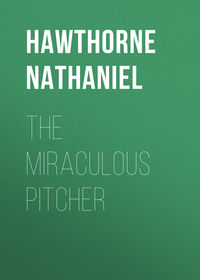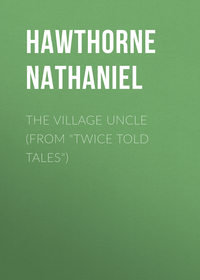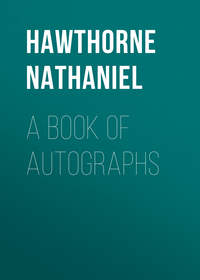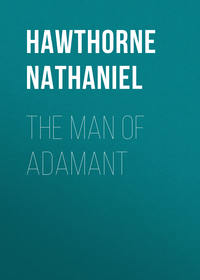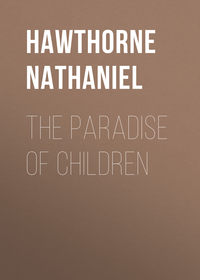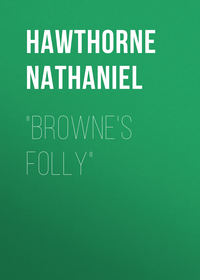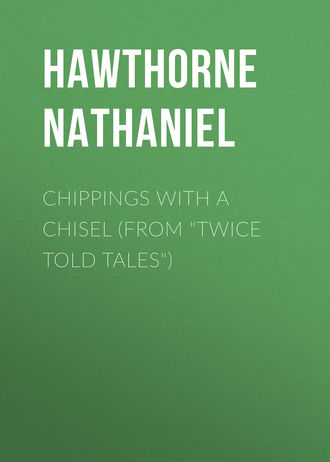 полная версия
полная версияChippings with a Chisel (From "Twice Told Tales")

Nathaniel Hawthorne
Chippings with a Chisel (From «Twice Told Tales»)
CHIPPINGS WITH A CHISEL
Passing a summer, several years since, at Edgartown, on the island of Martha’s Vineyard, I became acquainted with a certain carver of tombstones, who had travelled and voyaged thither from the interior of Massachusetts, in search of professional employment. The speculation had turned out so successful, that my friend expected to transmute slate and marble into silver and gold, to the amount of at least a thousand dollars, during the few months of his sojourn at Nantucket and the Vineyard. The secluded life, and the simple and primitive spirit which still characterizes the inhabitants of those islands, especially of Martha’s Vineyard, insure their dead friends a longer and dearer remembrance than the daily novelty and revolving bustle of the world can elsewhere afford to beings of the past. Yet while every family is anxious to erect a memorial to its departed members, the untainted breath of ocean bestows such health and length of days upon the people of the isles, as would cause a melancholy dearth of business to a resident artist in that line. His own monument, recording his disease by starvation, would probably be an early specimen of his skill. Gravestones, therefore, have generally been an article of imported merchandise.
In my walks through the burial-ground of Edgartown, – where the dead have lain so long that the soil, once enriched by their decay, has returned to its original barrenness, – in that ancient burial-ground I noticed much variety of monumental sculpture. The elder stones, dated a century back, or more, have borders elaborately carved with flowers, and are adorned with a multiplicity of death’s-heads, cross-bones, scythes, hour-glasses, and other lugubrious emblems of mortality, with here and there a winged cherub to direct the mourner’s spirit upward. These productions of Gothic taste must have been quite beyond the colonial skill of the day, and were probably carved in London, and brought across the ocean to commemorate the defunct worthies of this lonely isle. The more recent monuments are mere slabs of slate, in the ordinary style, without any superfluous flourishes to set off the bald inscriptions. But others – and those far the most impressive, both to my taste and feelings – were roughly hewn from the gray rocks of the island, evidently by the unskilled hands of surviving friends and relatives. On some there were merely the initials of a name; some were inscribed with misspelt prose or rhyme, in deep letters, which the moss and wintry rain of many years had not been able to obliterate. These, these were graves where loved ones slept! It is an old theme of satire, the falsehood and vanity of monumental eulogies; but when affection and sorrow grave the letters with their own painful labor, then we may be sure that they copy from the record on their hearts.
My acquaintance, the sculptor, – he may share that title with Greenough, since the dauber of signs is a painter as well as Raphael, – had found a ready market for all his blank slabs of marble, and full occupation in lettering and ornamenting them. He was an elderly man, a descendant of the old Puritan family of Wigglesworth, with a certain simplicity and singleness, both of heart and mind, which, methinks, is more rarely-found among us Yankees than in any other community of people. In spite of his gray head and wrinkled brow, he was quite like a child in all matters save what had some reference to his own business; he seemed, unless my fancy misled me, to view mankind in no other relation than as people in want of tombstones; and his literary attainments evidently comprehended very little, either of prose or poetry, which had not, at one time or other, been inscribed on slate or marble. His sole task and office among the immortal pilgrims of the tomb – the duty for which Providence had sent the old man into the world, as it were with a chisel in his hand – was to label the dead bodies, lest their names should be forgotten at the resurrection. Yet he had not failed, within a narrow scope, to gather a few sprigs of earthly, and more than earthly, wisdom, – the harvest of many a grave.
And lugubrious as his calling might appear, he was as cheerful an old soul as health, and integrity, and lack of care, could make him, and used to set to work upon one sorrowful inscription or another with that sort of spirit which impels a man to sing at his labor. On the whole, I found Mr. Wigglesworth an entertaining, and often instructive, if not an interesting character; and partly for the charm of his society, and still more because his work has an invariable attraction for “man that is born of woman,” I was accustomed to spend some hours a day at his workshop. The quaintness of his remarks, and their not infrequent truth, – a truth condensed and pointed by the limited sphere of his view, – gave a raciness to his talk, which mere worldliness and general cultivation would at once have destroyed.
Sometimes we would discuss the respective merits of the various qualities of marble, numerous slabs of which were resting against the walls of the shop; or sometimes an hour or two would pass quietly, without a word on either side, while I watched how neatly his chisel struck out letter after letter of the names of the Nortons, the Mayhews, the Luces, the Daggets, and other immemorial families of the Vineyard. Often, with an artist’s pride, the good old sculptor would speak of favorite productions of his skill, which were scattered throughout the village graveyards of New England. But my chief and most instructive amusement was to witness his interviews with his customers, who held interminable consultations about the form and fashion of the desired monuments, the buried excellence to be commemorated, the anguish to be expressed, and finally, the lowest price in dollars and cents for which a marble transcript of their feelings might be obtained. Really, my mind received many fresh ideas, which, perhaps, may remain in it even longer than Mr. Wigglesworth’s hardest marble will retain the deepest strokes of his chisel.
An elderly lady came to bespeak a monument for her first love, who had been killed by a whale in the Pacific Ocean no less than forty years before. It was singular that so strong an impression of early feeling should have survived through the changes of her subsequent life, in the course of which she had been a wife and a mother, and, so far as I could judge, a comfortable and happy woman. Reflecting within myself, it appeared to me that this lifelong sorrow – as, in all good faith, she deemed it – was one of the most fortunate circumstances of her history. It had given an ideality to her mind; it had kept her purer and less earthly than she would otherwise have been, by drawing a portion of her sympathies apart from earth. Amid the throng of enjoyments, and the pressure of worldly care, and all the warm materialism of this life, she had communed with a vision, and had been the better for such intercourse. Faithful to the husband of her maturity, and loving him with a far more real affection than she ever could have felt for this dream of her girlhood, there had still been an imaginative faith to the ocean-buried, so that an ordinary character had thus been elevated and refined. Her sighs had been the breath of Heaven to her soul. The good lady earnestly desired that the proposed monument should be ornamented with a carved border of marine plants, intertwined with twisted sea-shells, such as were probably waving over her lover’s skeleton, or strewn around it, in the far depths of the Pacific. But Mr. Wigglesworth’s chisel being inadequate to the task, she was forced to content herself with a rose, hanging its head from a broken stem. After her departure, I remarked that the symbol was none of the most apt.
“And yet,” said my friend the sculptor, embodying in this image the thoughts that had been passing through my own mind, “that broken rose has shed its sweet smell through forty years of the good woman’s life.”
It was seldom that I could find such pleasant food for contemplation as in the above instance. None off the applicants, I think, affected me more disagreeably than an old man who came, with his fourth wife hanging on his arm, to bespeak gravestones for the three former occupants of his marriage-bed. I watched with some anxiety to see whether his remembrance of either were more affectionate than of the other two, but could discover no symptom of the kind. The three monuments were all to be of the same material and form, and each decorated, in bas-relief, with two weeping-willows, one of these sympathetic trees bending over its fellow, which was to be broken in the midst and rest upon a sepulchral urn. This, indeed, was Mr. Wigglesworth’s standing emblem of conjugal bereavement. I shuddered at the gray polygamist, who had so utterly lost the holy sense of individuality in wedlock, that methought he was fain to reckon upon his fingers how many women, who had once slept by his side, were now sleeping in their graves. There was even – if I wrong him it is no great matter – a glance sidelong at his living spouse, as if he were inclined to drive a thriftier bargain by bespeaking four gravestones in a lot. I was better pleased with a rough old whaling captain, who gave directions for a broad marble slab, divided into two compartments, one of which was to contain an epitaph on his deceased wife, and the other to be left vacant, till death should engrave his own name there. As is frequently the case among the whalers of Martha’s Vineyard, so much of this storm-beaten widower’s life had been tossed away on distant seas, that out of twenty years of matrimony he had spent scarce three, and those at scattered intervals, beneath his own roof. Thus the wife of his youth, though she died in his and her declining age, retained the bridal dewdrops fresh around her memory.
My observations gave me the idea, and Mr. Wigglesworth confirmed it, that husbands were more faithful in setting up memorials to their dead wives than widows to their dead husbands. I was not ill-natured enough to fancy that women, less than men, feel so sure of their own constancy as to be willing to give a pledge of it in marble. It is more probably the fact, that while men are able to reflect upon their lost companions as remembrances apart from themselves, women, on the other hand, are conscious that a portion of their being has gone with the departed whithersoever he has gone. Soul clings to soul; the living dust has a sympathy with the dust of the grave; and, by the very strength of that sympathy, the wife of the dead shrinks the more sensitively from reminding the world of its existence. The link is already strong enough; it needs no visible symbol. And, though a shadow walks ever by her side, and the touch of a chill hand is on her bosom, yet life, and perchance its natural yearnings, may still be warm within her, and inspire her with new hopes of happiness. Then would she mark out the grave, the scent of which would be perceptible on the pillow of the second bridal? No – but rather level its green mound with the surrounding earth, as if, when she dug up again her buried heart, the spot had ceased to be a grave. Yet, in spite of these sentimentalities, I was prodigiously amused by an incident, of which I had not the good fortune to be a witness, but which Mr. Wigglesworth related with considerable humor. A gentlewoman of the town, receiving news of her husband’s loss at sea, had bespoken a handsome slab of marble, and came daily to watch the progress of my friend’s chisel. One afternoon, when the good lady and the sculptor were in the very midst of the epitaph, which the departed spirit might have been greatly comforted to read, who should walk into the workshop but the deceased himself, in substance as well as spirit! He had been picked up at sea, and stood in no present need of tombstone or epitaph.
“And how,” inquired I, “did his wife bear the shock of joyful surprise?”
“Why,” said the old man, deepening the grin of a death’s-head, on which his chisel was just then employed, “I really felt for the poor woman; it was one of my best pieces of marble, – and to be thrown away on a living man!”
A comely woman, with a pretty rosebud of a daughter, came to select a gravestone for a twin-daughter, who had died a month before. I was impressed with the different nature of their feelings for the dead; the mother was calm and wofully resigned, fully conscious of her loss, as of a treasure which she had not always possessed, and, therefore, had been aware that it might be taken from her; but the daughter evidently had no real knowledge of what death’s doings were. Her thoughts knew, but not her heart. It seemed to me, that by the print and pressure which the dead sister had left upon the survivor’s spirit, her feelings were almost the same as if she still stood side by side, and arm in arm, with the departed, looking at the slabs of marble; and once or twice she glanced around with a sunny smile, which, as its sister smile had faded forever, soon grew confusedly overshadowed. Perchance her consciousness was truer than her reflection, – perchance her dead sister was a closer companion than in life. The mother and daughter talked a long while with Mr. Wigglesworth about a suitable epitaph, and finally chose an ordinary verse of ill-matched rhymes, which had already been inscribed upon innumerable tombstones. But, when we ridicule the triteness of monumental verses, we forget that Sorrow reads far deeper in them than we can, and finds a profound and individual purport in what seems so vague and inexpressive, unless interpreted by her. She makes the epitaph anew, though the self-same words may have served for a thousand graves.
“And yet,” said I afterwards to Mr. Wigglesworth, “they might have made a better choice than this. While you were discussing the subject, I was struck by at least a dozen simple and natural expressions from the lips of both mother and daughter. One of these would have formed an inscription equally original and appropriate.”
“No, no,” replied the sculptor, shaking his head, “there is a good deal of comfort to be gathered from these little old scraps of poetry; and so I always recommend them in preference to any new-fangled ones. And somehow, they seem to stretch to suit a great grief, and shrink to fit a small one.”
It was not seldom that ludicrous images were excited by what took place between Mr. Wigglesworth and his customers. A shrewd gentlewoman, who kept a tavern in the town, was anxious to obtain two or three gravestones for the deceased members of her family, and to pay for these solemn commodities by taking the sculptor to board. Hereupon a fantasy arose in my mind, of good Mr. Wigglesworth sitting down to dinner at a broad, flat tombstone, carving one of his own plump little marble cherubs, gnawing a pair of cross-bones, and drinking out of a hollow death’s-head, or perhaps a lachrymatory vase, or sepulchral urn; while his hostess’s dead children waited on him at the ghastly banquet. On communicating this nonsensical picture to the old man, he laughed heartily, and pronounced my humor to be of the right sort.
“I have lived at such a table all my days,” said he, “and eaten no small quantity of slate and marble.”
“Hard fare!” rejoined I, smiling; “but you seemed to have found it excellent of digestion, too.”
A man of fifty, or thereabouts, with a harsh, unpleasant countenance, ordered a stone for the grave of his bitter enemy with whom he had waged warfare half a lifetime, to their mutual misery and ruin. The secret of this phenomenon was, that hatred had become the sustenance and enjoyment of the poor wretch’s soul; it had supplied the place of all kindly affections; it had been really a bond of sympathy between himself and the man who shared the passion; and when its object died, the unappeasable foe was the only mourner for the dead. He expressed a purpose of being buried side by side with his enemy.
“I doubt whether their dust will mingle,” remarked the old sculptor to me; for often there was an earthliness in his conceptions.
“O yes,” replied I, who had mused long upon the incident; “and when they rise again, these bitter foes may find themselves dear friends. Methinks what they mistook for hatred was but love under a mask.”
A gentleman of antiquarian propensities provided a memorial for an Indian of Chabbiquidick, one of the few of untainted blood remaining in that region, and said to be an hereditary chieftain, descended from the sachem who welcomed Governor Mayhew to the Vineyard. Mr. Wigglesworth exerted his best skill to carve a broken bow and scattered sheaf of arrows, in memory of the hunters and warriors whose race was ended here; but he likewise sculptured a cherub, to denote that the poor Indian had shared the Christian’s hope of immortality.
“Why,” observed I, taking a perverse view of the winged boy and the bow and arrows, “it looks more like Cupid’s tomb than an Indian chief’s!”
“You talk nonsense,” said the sculptor, with the offended pride of art; he then added, with his usual good-nature, “How can Cupid die when there are such pretty maidens in the Vineyard?”
“Very true,” answered I; and for the rest of the day I thought of other matters than tombstones.
At our next meeting I found him chiselling an open book upon a marble headstone, and concluded that it was meant to express the erudition of some black-letter clergyman of the Cotton Mather school. It turned out, however, to be emblematical of the scriptural knowledge of an old woman who had never read anything but her Bible; and the monument was a tribute to her piety and good works, from the Orthodox church, of which she had been a member. In strange contrast with this Christian woman’s memorial, was that of an infidel, whose gravestone, by his own direction, bore an avowal of his belief that the spirt within him would be extinguished like a flame, and that the nothingness whence he sprang would receive him again. Mr. Wigglesworth consulted me as to the propriety of enabling a dead man’s dust to utter this dreadful creed.
“If I thought,” said he, “that a single mortal would read the inscription without a shudder, my chisel should never cut a letter of it. But when the grave speaks such falsehoods, the soul of man will know the truth by its own horror.”
“So it will,” said I, struck by the idea; “the poor infidel may strive to preach blasphemies from his grave; but it will be only another method of impressing the soul with a consciousness of immortality.”
There was an old man by the name of Norton, noted throughout the island for his great wealth, which he had accumulated by the exercise of strong and shrewd faculties, combined with a most penurious disposition. This wretched miser, conscious that he had not a friend to be mindful of him in his grave, had himself taken the needful precautions for posthumous remembrance, by bespeaking an immense slab of white marble, with a long epitaph in raised letters, the whole to be as magnificent as Mr. Wigglesworth’s skill could make it. There was something very characteristic in this contrivance to have his money’s worth even from his own tombstone, which, indeed, afforded him more enjoyment in the few months that he lived thereafter, than it probably will in a whole century, now that it is laid over his bones. This incident reminds me of a young girl, a pale, slender, feeble creature, most unlike the other rosy and healthful damsels of the Vineyard, amid whose brightness she was fading away. Day after day did the poor maiden come to the sculptor’s shop, and pass from one piece of marble to another, till at last she pencilled her name upon a slender slab, which, I think, was of a more spotless white than all the rest. I saw her no more, but soon afterwards found Mr. Wigglesworth cutting her virgin name into the stone which she had chosen.
“She is dead, – poor girl,” said he, interrupting the tune which he was whistling, “and she chose a good piece of stuff for her headstone. Now which of these slabs would you like best to see your own name upon?”
“Why, to tell you the truth, my good Mr. Wigglesworth,” replied I, after a moment’s pause, – for the abruptness of the question had somewhat startled me, – “to be quite sincere with you, I care little or nothing about a stone for my own grave, and am somewhat inclined to scepticism as to the propriety of erecting monuments at all, over the dust that once was human. The weight of these heavy marbles, though unfelt by the dead corpse of the enfranchised soul, presses drearily upon the spirit of the survivor, and causes him to connect the idea of death with the dungeon-like imprisonment of the tomb, instead of with the freedom of the skies. Every gravestone that you ever made is the visible symbol of a mistaken system. Our thoughts should soar upward with the butterfly, – not linger with the exuviae that confined him. In truth and reason, neither those whom we call the living, and still less the departed, have anything to do with the grave.”
“I never heard anything so heathenish!” said Mr. Wigglesworth, perplexed and displeased at sentiments which controverted all his notions and feelings, and implied the utter waste, and worse, of his whole life’s labor; “would you forget your dead friends, the moment they are under the sod?”
“They are not under the sod,” I rejoined; “then why should I mark the spot where there is no treasure hidden! Forget them? No! But to remember them aright, I would forget what they have cast off. And, to gain the truer conception of DEATH, I would forget them GRAVE!”
But still the good old sculptor murmured, and stumbled, as it were, over the gravestones amid which he had walked through life. Whether he were right or wrong, I had grown the wiser from our companionship and from my observations of nature and character, as displayed by those who came, with their old griefs or their new ones, to get them recorded upon his slabs of marble. And yet, with my gain of wisdom, I had likewise gained perplexity; for there was a strange doubt in my mind, whether the dark shadowing of this life, the sorrows and regrets, have not as much real comfort in them – leaving religious influences out of the question – as what we term life’s joys.


